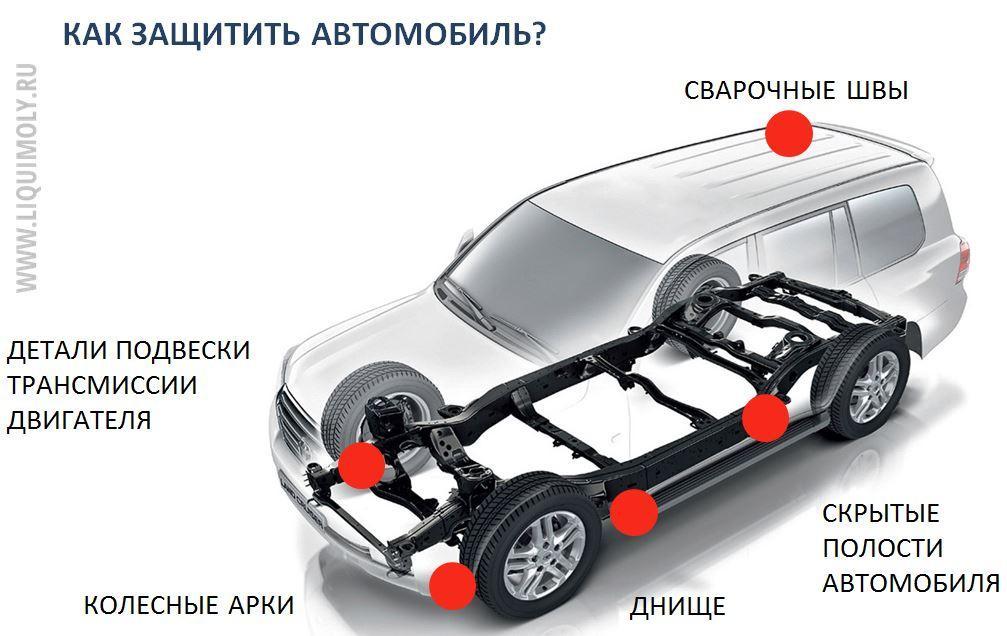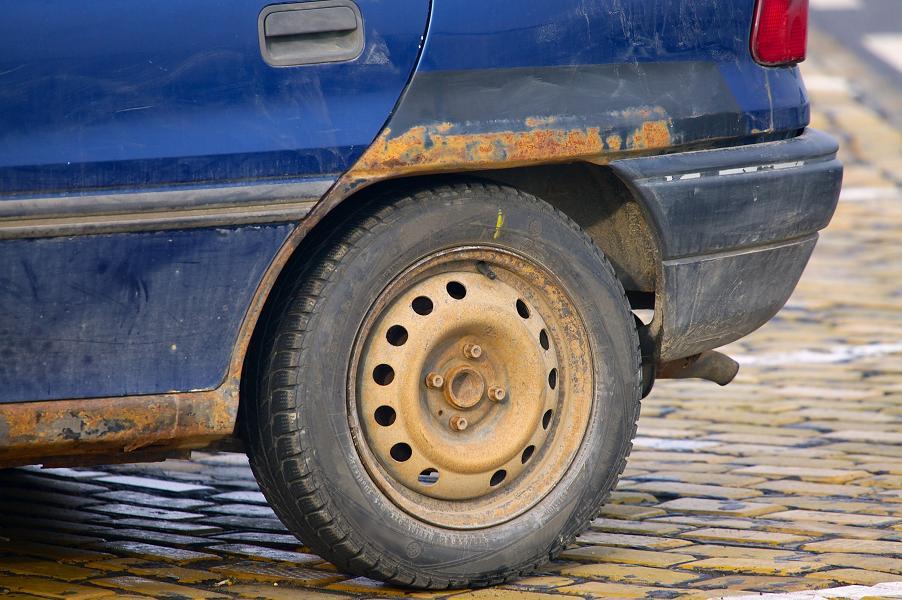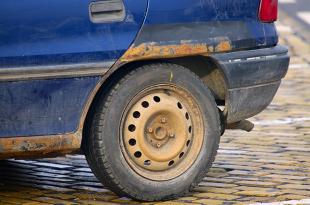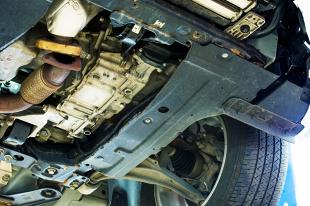
How to protect a car from corrosion?
 Rust on the car, if it appears, is almost impossible to remove. This is why the best way to fight corrosion is to effectively prevent it from occurring. So how do you protect yourself from it?
Rust on the car, if it appears, is almost impossible to remove. This is why the best way to fight corrosion is to effectively prevent it from occurring. So how do you protect yourself from it?
Deadly disease for the car
 Rust is primarily associated with a reduction in the aesthetic value of any corroded car and high repair costs. In case of surface corrosion, the first rescue, of course, will be a visit to the painter. Unfortunately, even the best specialists are not able to make corrections that are invisible to the eye, so each repair will directly affect the aesthetics of the car. Painting is also expensive. We will pay an average of PLN 300 to PLN 500 for covering one element, so in case of corrosion on the doors and fenders, we can pay up to PLN 2 at a time. zloty.
Rust is primarily associated with a reduction in the aesthetic value of any corroded car and high repair costs. In case of surface corrosion, the first rescue, of course, will be a visit to the painter. Unfortunately, even the best specialists are not able to make corrections that are invisible to the eye, so each repair will directly affect the aesthetics of the car. Painting is also expensive. We will pay an average of PLN 300 to PLN 500 for covering one element, so in case of corrosion on the doors and fenders, we can pay up to PLN 2 at a time. zloty.
However, the appearance of the car is not the only victim of rust. Not everyone realizes that this could lead to many more serious threats. Ignoring corrosion on our car can not only reduce the thickness of our wallet, but also directly affect driving safety. Rusted car components behave unpredictably even in seemingly harmless accidents, which drastically reduces the level of driving safety. The appearance of rust on the undercarriage components, such as the swingarm mount, can cause them to come off while driving, with a direct risk to the lives of passengers. Similarly, the dangerous presence of "redheads" on shock absorbers can be a major cause of an accident. Other, less life-threatening, but certainly for the driver's wallet, the effects of corrosion can appear on the cooling system. Rust near the system can spread to the electronic circuitry, which can overheat or even melt the insulation. The most notable corrosion problem concerns body parts. Fender flares, doors or fenders affected by rust can mean that corrosion is already covering the sills, spars and floor of the vehicle. The flexible connections of the chassis, i.e. all areas around the gaskets, are equally susceptible to rust. Corrosion should not necessarily be the result of many years of driving on salty winter roads, but evidence of the savings of some manufacturers on paint, thin sheets or poor-quality anti-corrosion protection.
Some car models are simply more prone to rust than others. In the case of such models, close attention should be paid to the condition of the car body. Cheaper dates are often not effectively protected against corrosion around gutters, door bottoms, or fuel tank niches. Daewoo, once popular in Poland, often corrodes the tailgate, wheel arches and door edges. The same elements hit most older Ford models. Even gems like Mercedes, especially pre-2008 models, have components that are very susceptible to corrosion. In their case, you should inspect the lower parts of the door, check what is happening under the seals at the level of the windows, on the wheel arches and around the locks or decorative trims. There are also safer cars.  owners rarely complain about the rust problem. These are, for example, Volkswagen, Skoda and Volvo. However, when planning to buy such a used car, we cannot be sure of its entire past, especially that German or Scandinavian types are very often imported products, most often damaged in accidents. Then it is difficult to count on the safety of the manufacturer.
owners rarely complain about the rust problem. These are, for example, Volkswagen, Skoda and Volvo. However, when planning to buy such a used car, we cannot be sure of its entire past, especially that German or Scandinavian types are very often imported products, most often damaged in accidents. Then it is difficult to count on the safety of the manufacturer.
- Some car models, more prone to rust than others, have nothing to do with repairs. Even if the rusted elements are cut out by a specialist and supplemented with a repertoire, this may turn out to be ineffective. In the case of susceptible vehicles, on elements such as wheel arches, doors or sills, after professional sheet metal repair, unevenness under the paint may appear only after 2 years. They are indicative of a growing rust spot,” says Bogdan Ruczynski of Rust Check Poland.
Protect your car from corrosion yourself
Corrosion protection does not necessarily mean a visit to a car repair shop. Various self-applying products are available on the market that will effectively protect an unpolluted vehicle from corrosion. However, one should not trust the so-called universal means. Effective vehicle protection is ensured by the use of individual internal protection measures and individual external vehicle protection measures. Internal protection covers all components at risk of corrosion due to moisture and air ingress into the vehicle. We are talking about all the nooks and crannies of the chassis, gaps, as well as moving parts, such as locks. Protective preparations are applied by aerosol through drain holes and technological holes, so there is no need to disassemble individual parts of the car. For external protection, preparations are used to protect against direct weather conditions, i.e. body and  chassis, but also steel rims. The application for such elements is more convenient. We spray directly on wheel arches, rims, suspension systems or chassis components that are directly exposed to salt and water. Aerosol is not the only form of application of anti-corrosion preparations. If we have access to a spray gun, it will certainly be more convenient to apply the product on such a large device as a car.
chassis, but also steel rims. The application for such elements is more convenient. We spray directly on wheel arches, rims, suspension systems or chassis components that are directly exposed to salt and water. Aerosol is not the only form of application of anti-corrosion preparations. If we have access to a spray gun, it will certainly be more convenient to apply the product on such a large device as a car.
Complex only in the workshop
However, in the case of buying a used car or needing to stop developing pockets of rust on an old car, it is not enough to apply protective preparations on your own. A workshop visit will be required for this type of protection.
– In the case of used vehicles with an unverified history, it is recommended to use the comprehensive corrosion protection service offered by professional workshops. Thanks to this, we will not only protect the car coatings from corrosion, but also stop the possible development of existing rust pockets,” adds Bogdan Ruchinsky.
Comprehensive anti-corrosion protection consists in injecting protective agents into the closed profiles of the car and protecting the entire chassis with a new repair layer. Through such measures, we can not only protect the car from the development of rust, but also improve the possible savings made by some automakers on paint, sheet metal and factory anti-corrosion protection. However, it is important to entrust these activities to specialists who will ensure that the factory drain holes are not clogged, because in this way, instead of protecting the car from rust, we will help its development. Regardless of whether we just bought a used car or we drive the same vehicle from a new one, every 2-3 years the car should undergo a comprehensive maintenance.
